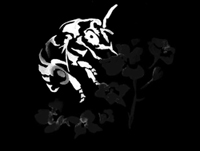Stocking Rates and Colony Strength
Stocking rates: Recommended stocking rates for crop pollination (e.g., # of honey bee hives per hectare) are based on several different factors. These includes the number of flowers per hectare, the time it takes for a bee to effectively pollinate a single flower, the number of bees in a hive that are actively foraging, the number of hours per day that they forage, and the relative attractiveness of the target blossoms (less attractive crops require more bees to get the required density of pollinators). Any of these factors can vary considerably across an area as large as Ontario, and weather can also strongly affect pollinator activity on a crop. Recommended rates for specific crops can be found in the section on individual crops. These recommendations are based on accepted colony strength standards.
It is common to add extra honey bee hives to a crop when there is low pollination due to low floral attractiveness of the crop, competing blooms, or a natural aversion of the honey bees to the flowers (for example, in alfalfa). These additional hives can exceed the capacity of the crop to nourish the bees and lead to widespread starvation in the managed hives. This could be avoided if wild pollinators, many of which are more efficient for particular crops (i.e. orchard fruit, alfalfa, vine crops), are encouraged and used instead.
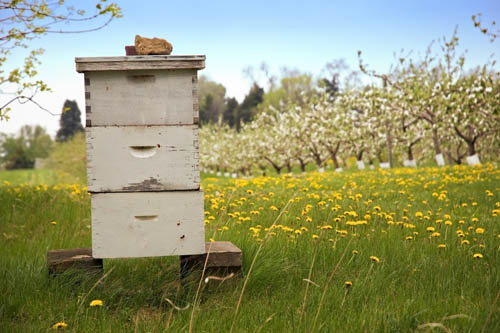
Honey bee hive in an apple orchard
Colony Strength: An important factor to consider in using honey bees for pollination is colony strength. This is a measure of the number of bees in the hive and their health. A beekeeper may provide legal documentation of the strength of the supplied colonies, certified by an apicultural consultant.
An accurate but labour-intensive method is the counting of "frames", estimating the quantity of brood and number of adult bees available for pollination as a representation of colony health. The number of bees on the frames may be lower if it is a warm sunny day and a significant proportion of foragers are outside the hive. A strong colony will produce plenty of foraging workers to visit the crop. If the weather conditions are suitable for foraging (15°C or higher and low wind speed), strength can be evaluated by counting the number of bees active at the hive entrance.
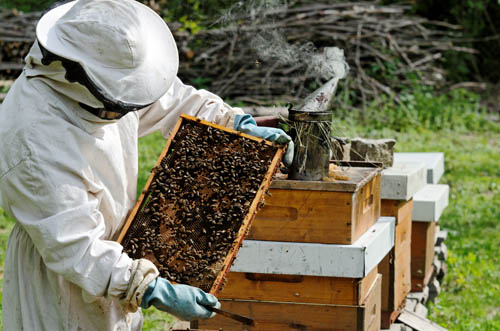
Inspecting a frame
The Canadian Honey Council recommends a minimum of 60 bees leaving the hive per minute under these conditions. A significant number of returning foragers (about one-third) carrying pollen signifies that enough bees are foraging for pollen, and also that the colony is actively rearing brood. Plenty of brood stimulate the foragers to collect pollen, which will improve pollination of the crop. A hive used for pollination should have a minimum of two Langstroth hive bodies (boxes) to allow expansion of the colony and discourage swarming resulting from overcrowding. Overcrowded bees will reduce their brood production and foraging activity, and are less effective crop pollinators.
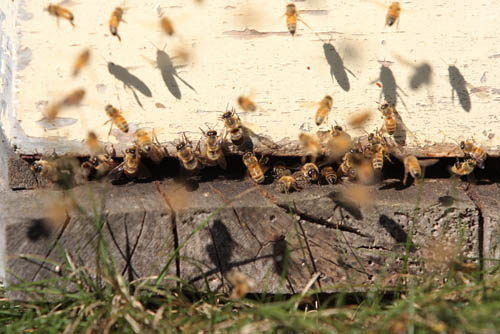
A minimum of 60 bees should leave the hive per minute under suitable foraging weather conditions
If the weather is less amenable to foraging, colony strength can be estimated by counting "frames". Colonies suitable for pollination in Ontario will contain a healthy laying queen, at least 20000 cm2 of comb with 6500 cm2 filled with live brood, and enough adult bees to cover 8-10 standard frames. For crops that bloom early in the season (i.e. orchard fruit), a suitable colony may have 6-8 frames of adult bees and 4000 cm2 of live brood, as there has been little time for strength to build after the winter. Grade B colonies, which may be available for a reduced pollination fee, may have up to 25% fewer adult bees and 25% less brood coverage.
Colonies should be free of American foulbrood, and have minimal indication of other diseases, such as European foulbrood. A similar but quicker method of estimating strength evaluates the size of the cluster only (frames covered with adult bees), and bees do not have to be shaken off the frames in order for the brood to be evaluated.
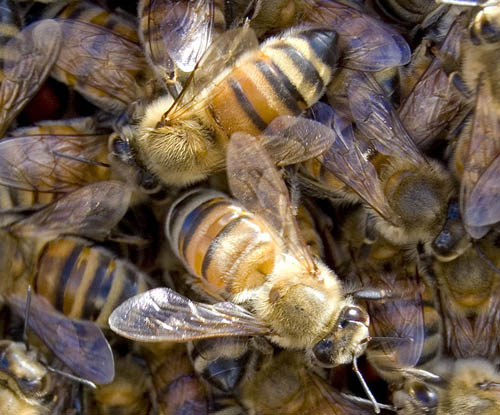
(Photo by Stephen Humphrey)
